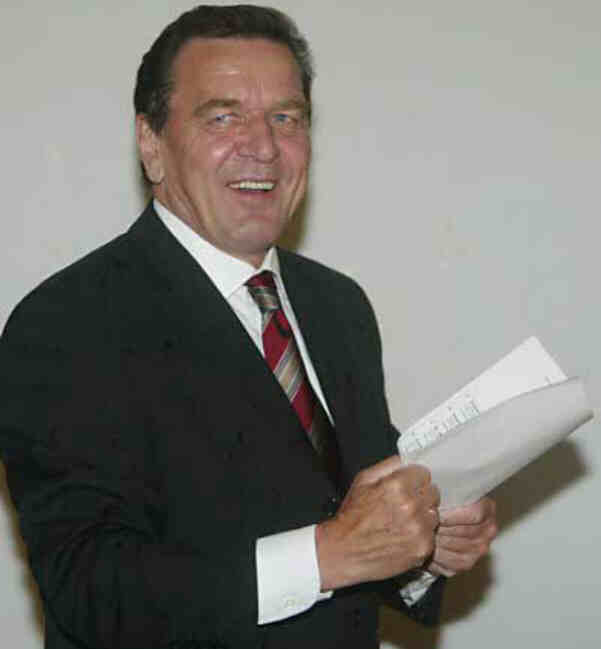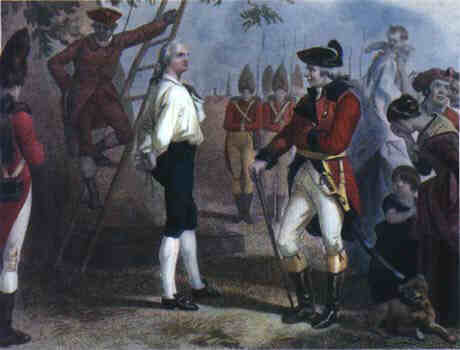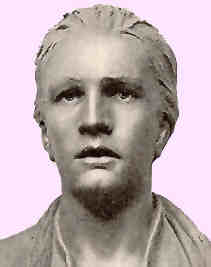Deaths which occurred on
a 22 September: ^top^
|
2002 Joseph Nathan Kane,
writer of books of facts.
Kane [1999 photo >],
born on 23 January 1899, wrote reference works that cataloged
such things as the nicknames of presidents, when the first
Eskimo Pie was created (1922), when the first camels were
brought to America (1721) and the 1849 patent number of the
first safety pin in the United States (6281). Among his books
were Famous First Facts: A Record of First Happenings,
Discoveries and Inventions in the United States (1933);
More First Facts (1935); 1000 Facts Worth Knowing
(1938); What Dog Is That? (1944), a summary of the
characteristics of 122 purebreds recognized by the American
Kennel Club. He also wrote an official history of the King
Solomon Lodge No. 279 of the Free and Accepted Masons, of
which he was a member.
He was not the first US factualist
(Henry W. Ruoff edited a Standard Dictionary of Facts
in 1914). Kane specialized in Americana. In Kane's work one
learns that James Madison was the shortest US president,
at 5 feet 4 inches, and that Madison's last words were, "I
always talk better lying down." Mr. Kane was not just a trivialist
— he was a factualist with a conscience who cared passionately
about giving credit where credit was due.
He mentioned the New Yorker
Walter Hunt, who is believed to have devised the first US
stitch-lock sewing machine in 1832, but failed to patent
it, so that credit went to Elias Howe, A. B. Wilson and Isaac
Singer, who came later.
Kane determined that the first
US commercially built automobiles were not the work of Henry
Ford or Walter Chrysler or David Buick, but of Charles Edgar
Duryea, who opened the Duryea Motor Wagon Company in Springfield,
Massachusetts, in 1895.
From Kane one learned that
Grover Cleveland had 20 nicknames, more than any other president.
They included Dumb Prophet, Buffalo Hangman, Grover the Good,
Old Veto and Perpetual Candidate.
Kane insisted that the US
Declaration of Independence was not signed on 04 July 1776.
He said that it was fairly engrossed on parchment on 19 July
and not signed by 50 of those who agreed to it until 02 August
1776. Six others did not sign it until even later.
Kane even determined that George
Washington was not really the first president of the United
States. Washington did not get the job until the Constitution
was ratified. But Thomas McKean was named president of the
United States back in 1781 by the Congress that convened
under the Articles of Confederation — eight years before
Washington took office.
Kane's last book was Necessity's
Child: The Story of Walter Hunt, America's Forgotten Inventor
(1997) about the inventor of the sewing machine, the fountain
pen, and the safety pin.
After the WW I, Kane was hired
by a New York confectioner, D. Auerbach & Sons, because he
could speak and read French, German and Spanish. He eventually
ran the export division, and began writing articles about
the export business for trade journals. His material was
syndicated for many years, and he also wrote for publications
including Advertising Age, Printers' Ink and Nation's
Business. He also wrote articles for newspapers.
In the late 1920's he decided
to write his first book about achievers forgotten by history.
It was rejected by 11 publishers, but the 12th, H. W. Wilson,
accepted it, and thus in Famous First Facts the world
learned that the first sheep were imported into the United
States in 1609, that the first Black US Army major was Martin
Robinson Delaney, and that the first subway built in the
US (in 1870) was the Beach Pneumatic Underground Railway
in New York. In a brief unsigned review of that book in 1933,
The Times said the author showed "a dogged resolution of
almost superhuman force."
Kane listed people who had
been named after George Washington. Besides George Washington
Carver, the agricultural chemist, there was a George Washington
Julian, who ran for vice president on the Free Soil Party
ticket; as well as George Washington Dixon, who became a
minstrel; George Washington Morgan, a colonel in the Mexican
War; and George Washington Crile, a doctor in the Spanish-American
War.
His research on the origins
of the names of all the counties in the United States was
published in 1955 as The American Counties: A Record of
the Origin of the Names of 3,067 Counties, Dates of Creation
and Organization, Area, Population, Historical Data, etc.
My own research has failed
to determine whether anyone ever called Kane, who never married,
by the pet name “Sugar”.
|
1989 Irving Berlin, 101, songwriter, in New York City.
1979 Ehresmann,
mathematician
1970 Jarnik,
mathematician
1923 Marquess of Ripon, game hunter, dies after shooting 52nd
grouse
1920 Herbert James Draper, born in 1864, British painter of historical
and imaginative subjects and portraits of his contemporaries. —
MORE ON DRAPER AT ART “4” SEPTEMBER
— LINKS
— Day
and the Dawn Star — Lancelot
and Guinevere — Naiad's
Pool — The
Sea Maiden (1894) — Calypso's
Isle (1897) — The Lament
for Icarus — The Water Nixie
— A Water Baby
(1900) — Tristram
and Iseult This painting was destroyed in WW II. — Sea
Melodies — The
Golden Fleece — Lamia
(1909) — Ulysses
and the Sirens — Flying
Fish —
Clyties of the Mist (The Mountain Mists). — Study
for Clyties of the Mist — The
Kelpie — Halcyone
1914 Five civilians as the German cruiser Emden shells Madras,
India, destroying 1'200'000 liters of fuel.
1914: Some 1400 British sailors
as U-Boat sinks 3 cruisers.
^top^
In the North Sea, one German submarine,
the U-9, sinks three British cruisers, the Aboukir, the
Hogue, and the Cressy, in just over one hour.
The one-sided battle, during which 1400 British sailors lost
their lives, alerted the British to the deadly effectiveness
of the submarine, which had been generally unrecognized up to
that time.
The German U-boat was a submarine
far more sophisticated than those built by other nations at
the time. The typical U-boat was 214 feet long, carried 35 men
and 12 torpedoes, and could travel underwater for two hours
at a time. In the first few years of World War I, the U-boats
took a terrible toll on Allied shipping. Germany's quarantine
of the British Isles was almost successful, but in 1917 unrestricted
U-boat attacks on neutral American vessels traveling to Britain
prompted the US entrance into the war. The infusion of American
ships, troops, and arms into World War I turned the tide of
the war against Germany. |
1913: 263 people killed in coal mine explosion at Dawson New Mexico
1906 Perhaps 16 blacks and 1
white killed on first day of Atlanta
race riot ^top^
Though Atlanta's rapid expansion
around 1900 was marked by the growth of both white and black
communities, these communities remained separate entities. Communities
throughout the South enacted Jim Crow laws to segregate blacks
and to subordinate them in almost every respect. Tensions between
the races heightened during the gubernatorial race of 1906.
The two leading candidates, Hoke Smith and Clark Howell, used
the Atlanta newspapers they controlled to wage a bitter campaign
based on racial hatred. The situation reached a climax on 22
September, when mobs of white Atlantans, enflamed by newspaper
reports of black indignities to white women, went through the
downtown area attacking and killing blacks on the streets, trolley
cars and even in stores. After a two-day rampage, 25 blacks
and one white were officially reported as dead, although unofficial
counts show that deaths on both sides were significantly higher.
— The
news reported at the time in the Atlanta Constitution
and the New York Times. |
1870 Louis Rémy Mignot, US Hudson River School painter,
specialized in landscapes, born in 1831. — LINKS
— Sunset
on White Mountains (1861)
1890 Auguste Etienne François Mayer, French artist born on 03
July 1805.
1837 Horner,
mathematician
1832 Philibert-Louis Debucourt, French artist born on 13 February
1755.— LINKS
1828 Shaka the great
Zulu king, murdered. ^top^
He is murdered by his half-brothers
Dingane and Mhlangana, and an induna (military officer),
Mbopa, when his customary cruelty (which make Attila and Ghengis
Khan look like humanitarians in comparison) reached absolute
insanity after his mother's death (for a whole year he prohibited
agriculture, milk, and had all pregnant women, and even cows,
massacred; but the last straw was when he tried to send his
impis — regiments — on an exhausting expedition without
rest from the previous one).
Shaka,founder of the Zulu Kingdom,
had been a highly successful military ruler, who completed the
centralization of Zulu power, developed the weapons and tactics
of southern African warfare, and set about the integration of
neighboring peoples into the growing Zulu Kingdom.
Shaka, founder of the Zulu Kingdom
of southern Africa, is murdered by his two half-brothers, Dingane
and Mhlangana, after Shaka's mental illness threatened to destroy
the Zulu tribe. When Shaka became chief of the Zulus in 1816,
the tribe numbered fewer than 1500 and was among the smaller
of the hundreds of other tribes in southern Africa. However,
Shaka proved a brilliant military organizer, forming well-commanded
regiments and arming his warriors with assegais, a new type
of long-bladed, short spear that was easy to wield and deadly.
The Zulus rapidly conquered neighboring tribes, incorporating
the survivors into their ranks. By 1823, Shaka was in control
of all of present-day Natal. The Zulu conquests greatly destabilized
the region and resulted in a great wave of migrations by uprooted
tribes.
In 1827, Shaka's mother, Nandi,
died, and the Zulu leader lost his mind. In his grief, Shaka
had hundreds of Zulus killed, and he outlawed the planting of
crops and the use of milk for a year. All women found pregnant
were murdered along with their husbands. He sent his army on
an extensive military operation, and when they returned exhausted
he immediately ordered them out again. It was the last straw
for the lesser Zulu chiefs: On 22 September 1828, his half-brothers
murdered Shaka. Dingane, one of the brothers, then became king
of the Zulus. |
|
 On
a 22 September:
On
a 22 September:  1776
Nathan Hale, 21,
1776
Nathan Hale, 21,  Disguised as a Dutch schoolmaster, Nathan Hale set out on his mission
on 12 September 1776. For over a week he gathered information on the
position of British troops but was captured os 21 September while returning,
near the American lines. Before being hanged he is reported to have said:
"I only regret that I have but one life to lose for my country."
Disguised as a Dutch schoolmaster, Nathan Hale set out on his mission
on 12 September 1776. For over a week he gathered information on the
position of British troops but was captured os 21 September while returning,
near the American lines. Before being hanged he is reported to have said:
"I only regret that I have but one life to lose for my country."